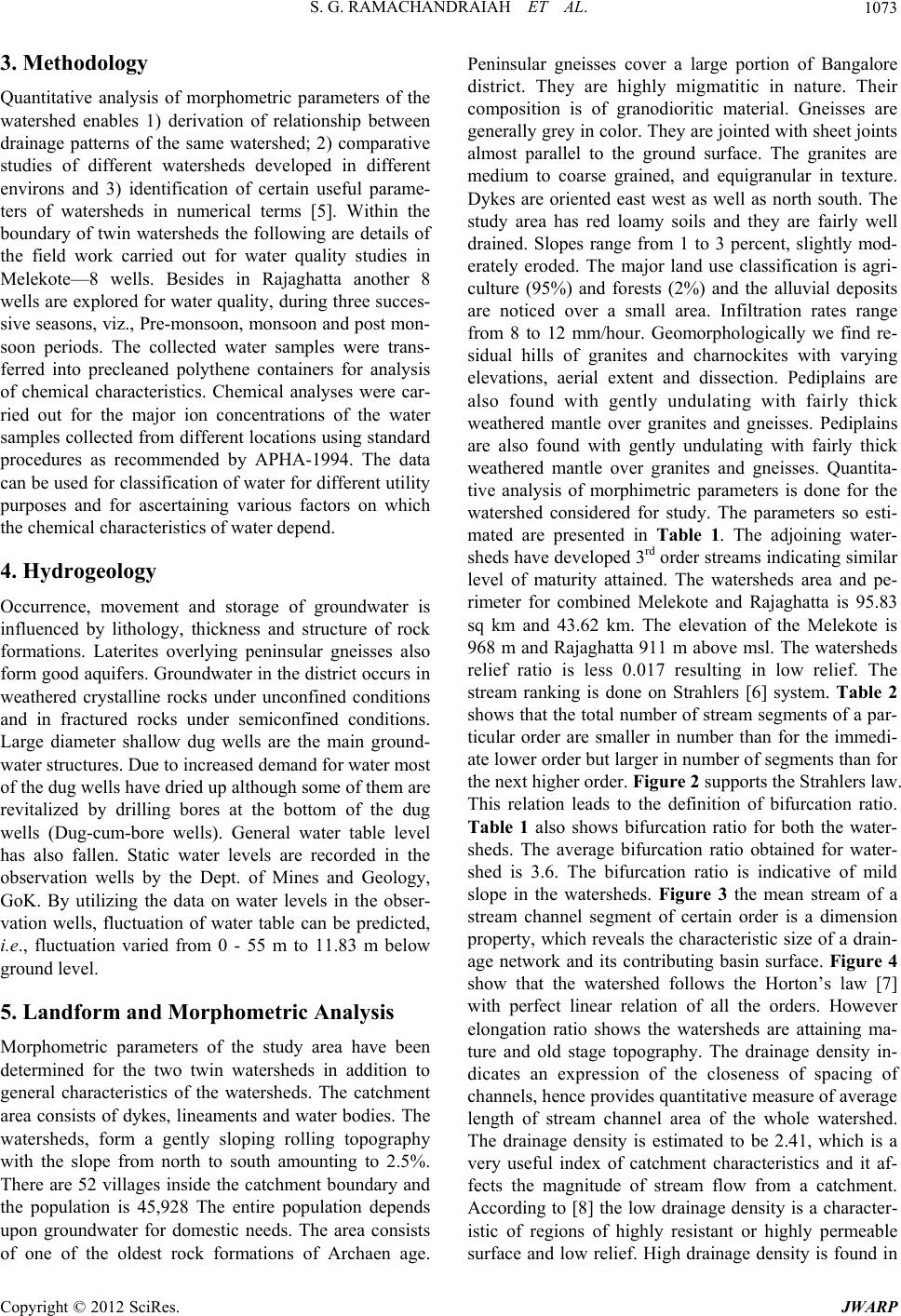
S. G. RAMACHANDRAIAH ET AL. 1073
3. Methodology
Quantitative analysis of morphometric parameters of the
watershed enables 1) derivation of relationship between
drainage patterns of the same watershed; 2) comparative
studies of different watersheds developed in different
environs and 3) identification of certain useful parame-
ters of watersheds in numerical terms [5]. Within the
boundary of twin watersheds the following are details of
the field work carried out for water quality studies in
Melekote—8 wells. Besides in Rajaghatta another 8
wells are explored for water quality, during three succes-
sive seasons, viz., Pre-monsoon, monsoon and post mon-
soon periods. The collected water samples were trans-
ferred into precleaned polythene containers for analysis
of chemical characteristics. Chemical analyses were car-
ried out for the major ion concentrations of the water
samples collected from different locations using standard
procedures as recommended by APHA-1994. The data
can be used for classification of water for different utility
purposes and for ascertaining various factors on which
the chemical characteristics of water depend.
4. Hydrogeology
Occurrence, movement and storage of groundwater is
influenced by lithology, thickness and structure of rock
formations. Laterites overlying peninsular gneisses also
form good aquifers. Groundwater in the district occurs in
weathered crystalline rocks under unconfined conditions
and in fractured rocks under semiconfined conditions.
Large diameter shallow dug wells are the main ground-
water structures. Due to increased demand for water most
of the dug wells have dried up although some of them are
revitalized by drilling bores at the bottom of the dug
wells (Dug-cum-bore wells). General water table level
has also fallen. Static water levels are recorded in the
observation wells by the Dept. of Mines and Geology,
GoK. By utilizing the data on water levels in the obser-
vation wells, fluctuation of water table can be predicted,
i.e., fluctuation varied from 0 - 55 m to 11.83 m below
ground leve l.
5. Landform and Morphometric Analysis
Morphometric parameters of the study area have been
determined for the two twin watersheds in addition to
general characteristics of the watersheds. The catchment
area consists of dykes, lineaments and water bodies. The
watersheds, form a gently sloping rolling topography
with the slope from north to south amounting to 2.5%.
There are 52 villages inside the catchment boundary and
the population is 45,928 The entire population depends
upon groundwater for domestic needs. The area consists
of one of the oldest rock formations of Archaen age.
Peninsular gneisses cover a large portion of Bangalore
district. They are highly migmatitic in nature. Their
composition is of granodioritic material. Gneisses are
generally grey in color. They are jointed with sheet joints
almost parallel to the ground surface. The granites are
medium to coarse grained, and equigranular in texture.
Dykes are oriented east west as well as north south. The
study area has red loamy soils and they are fairly well
drained. Slopes range from 1 to 3 percent, slightly mod-
erately eroded. The major land use classification is agri-
culture (95%) and forests (2%) and the alluvial deposits
are noticed over a small area. Infiltration rates range
from 8 to 12 mm/hour. Geomorphologically we find re-
sidual hills of granites and charnockites with varying
elevations, aerial extent and dissection. Pediplains are
also found with gently undulating with fairly thick
weathered mantle over granites and gneisses. Pediplains
are also found with gently undulating with fairly thick
weathered mantle over granites and gneisses. Quantita-
tive analysis of morphimetric parameters is done for the
watershed considered for study. The parameters so esti-
mated are presented in Table 1. The adjoining water-
sheds have developed 3rd order streams indicating similar
level of maturity attained. The watersheds area and pe-
rimeter for combined Melekote and Rajaghatta is 95.83
sq km and 43.62 km. The elevation of the Melekote is
968 m and Rajaghatta 911 m above msl. The watersheds
relief ratio is less 0.017 resulting in low relief. The
stream ranking is done on Strahlers [6] system. Table 2
shows that the total number of stream segments of a par-
ticular order are smaller in number than for the immedi-
ate lower order but larger in nu mber of segments than for
the next higher order. Figure 2 suppor ts th e Str ahlers law .
This relation leads to the definition of bifurcation ratio.
Table 1 also shows bifurcation ratio for both the water-
sheds. The average bifurcation ratio obtained for water-
shed is 3.6. The bifurcation ratio is indicative of mild
slope in the watersheds. Figure 3 the mean stream of a
stream channel segment of certain order is a dimension
property, which reveals the characteristic size of a drain-
age network and its contributing basin surface. Figure 4
show that the watershed follows the Horton’s law [7]
with perfect linear relation of all the orders. However
elongation ratio shows the watersheds are attaining ma-
ture and old stage topography. The drainage density in-
dicates an expression of the closeness of spacing of
channels, hence provides quantitativ e measure of averag e
length of stream channel area of the whole watershed.
The drainage density is estimated to be 2.41, which is a
very useful index of catchment characteristics and it af-
fects the magnitude of stream flow from a catchment.
According to [8] the low drainage density is a character-
istic of regions of highly resistant or highly permeable
surface and low relief. High drainage density is found in
Copyright © 2012 SciRes. JWARP